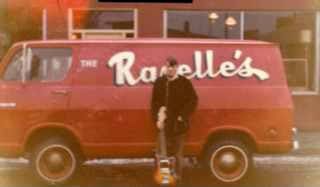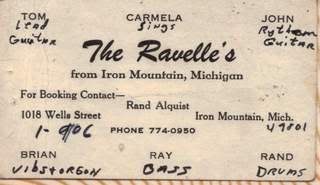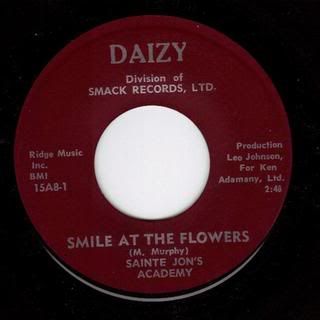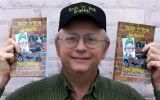
The Ravelles autographed this publicity photo, taken in 1966. The group included, standing, from left: Ray Broullire, Tom Lucas, Carmella Altobelli and John Richtig. In front: Brian and Rand Alquist.
By STEVE SEYMOUR
Iron Mountain's Ravelles rock band played hundreds of gigs in the upper midwest from the mid-1960s to the early 1970s, earning a reputation as an exceptional live act.
Besides the popular shows, often drawing 1,000 teens, the band's career encompassed a tour with the nationally-known Buckinghams and a pair of 45 rpm singles.
Originated by lead guitarist Tom Lucas and rhythm guitar player John Richtig, the band also included singer Carmella Altobelli, bassist Ray Broullire and brothers Rand and Brian Alquist, on drums and keyboards, respectively. Lucas and Richtig had played in an earlier group, the Trade Winds.
During a recent interview, Lucas recalled that the Ravelles competed aggressively for Altobelli, who was already known for her powerful voice while still in high school. Although rival band Joey Gee and the Blue Tones also wanted to add the female vocalist to their line-up, the singer decided to cast her lot with the Ravelles.
The combo honed their chops during practice sessions held at the home of Ward and LaVaughn Alquist, parents of band members Rand and Brian. Mrs. Alquist also came up with the group's name, Lucas recalled.
Richtig credited the elder Alquists with helping the band in numerous ways. In a diary Richtig kept, he commented that they never complained about the band practicing at their home, told them when they sounded good or when they didn't, and gave the group advice about their appearance. "I couldn't name all the ways they have helped us out," Richtig wrote.
Early on, the Ravelles played weddings as well as dances at the Iron Mountain High School and local teen club. Although Altobelli performed many lead vocals, everyone in the group sang, and the sextet became increasingly known for their harmonies.
In 1966, the year Richtig and Altobelli graduated from high school, the Ravelles got a chance to greatly expand their fan base when they were included in a "package tour" with Chicago's Buckinghams, an all-girl group called the Luv'd Ones, and Marquette's increasingly popular Excels.
Presented as "The U. P. Swings," the shows were billed as a "Wild Teen Promotion" and were emceed by disc jockey Bill Berline. At the time, the Buckinghams had just released their version of Lennon and McCartney's "I Call Your Name." The song was in heavy rotation on the Windy City's twin rock 'n' roll powerhouses, WLS and WCFL, while it wouldn't be until later in the year that the group would release their smash, "Kind of a Drag."
Led by Char Vinnedge, The Luv'd Ones were pushing their latest single, "I'm Leaving You." Unlike some of their contemporaries, these female musicians played their own instruments, adding plenty of fuzz guitar to their terrific original songs. However, they never had a hit.
The Ravelles also shared the stage with the Excels, a group of Northern Michigan University students recording for the Carla label in the lower peninsula. Only the Ravelles were unsigned at this time.
For a $2 admission fee, the groups played in Sault Ste. Marie, Escanaba, Menominee, Iron Mountain and Ironwood. During the stop at the Ironwood Theater, Lucas taped performances from all four groups.
After boosting their regional profile with "The U. P. Swings" performances, the Ravelles concentrated on the area dance circuit.

Lead guitarist Tom Lucas posed next to the Ravelles' van with his Fender Jazzmaster guitar for this picture on Jan. 1, 1967.
During 1967, the band played 103 jobs, according to Richtig's diary, performing before teenagers all over the central and western U. P. The group even extended its reach, performing numerous times in the neighboring Wisconsin communities of Green Bay, Florence, Denmark, Oshkosh and DePere. In fact, DePere's Prom Ballroom, a teen bar, became a frequent stop for the Ravelles.
They played there on Aug. 18 and 19, drawing 650 teens the first night and 850 the next. "Light My Fire" was a giant hit at this time and the Ravelles played the Doors' song six times on the 18th.
Richtig complimented Altobelli in his diary. "Carmella really is great. I knew she was great, but not this great! I guess I'm just starting to find out how important she really is!" Brian and Rand's parents, always supportive of the group, came to see the Ravelles on the 19th.
On Sept. 3, the band played for a dance in Escanaba put on by Elroy and Wilma Zimmermann. They were paid $130 and entertained about 250 people during a performance lasting from 8:30 to 11:30 p.m.
The group's recording prospects were bolstered on Oct. 7 when a talent agent from Rampro Records, based in Janesville, Wis., attended a show at Jordan Gym in Menominee.
The hard-working band's reputation and performance fees were both growing. During two shows at the Prom Ballroom in DePere on Dec. 1 and 2, almost 2,400 people showed up. The band was paid $350 each night.
During one of the last shows for the year, the Ravelles played for college students at the Terrace Motor Inn in Escanaba.
The year 1968 would be a momentous one for the Iron Mountain group. During a performance at Premontre High School in Green Bay on Jan. 6, the band was approached by an agent representing Ken Adamany, an influential promoter based in Madison. Richtig enthused in his diary: "Adamany's agent is really crazy over us. This may be our breakthrough!".
On Jan. 21, the Ravelles entertained at the high school in Powers. Richtig noted, "Skirts and dresses sure are short here."
The Ravelles used this business card to promote the band. Jobs were booked by drummer Rand Alquist.
The group played two more shows at the Prom Ballroom in DePere on Feb. 16 and 17, drawing about 1,000 teens each night. During a gig in Oshkosh the following week, the band was advised by a record company representative to work on choreography, a suggestion they took seriously.
During shows at the Cove teen bar in Oshkosh on Mar. 1 and 2, "Girls screamed when we announced 'Sittin' On The Dock of the Bay,' by Otis Redding," Richtig noted. Two weeks later, the band returned to Oshkosh, this time to the College Inn teen bar, when they played in new coats. Richtig also commented that 'Sunshine for Your Love' sounded good with added psychedelic effects.
Things were looking up for the Ravelles during a Mar. 29 show at Scott Hall in Oshkosh, when the group met James H. Manning, President of Chicago's Mobie Record Co.
On May 10 and 11, the Ravelles returned to the Prom Ballroom, playing before 1,000 teens the second night. It was here that they introduced "soul clapping," getting the audience involved in the show.
The next weekend, the group performed at the University of Wisconsin Union Hall in Madison, where they opened for the Cryan' Shames. The Cryan' Shames was another Chicago group, which had a hit with "Sugar and Spice."
With their calendar increasingly hectic, the Ravelles added Jerry Brouillire and Dave Richtig to the payroll as road managers. Their first job was a dance at the Negaunee teen center on May 24.
The following day, during a formal dance at West Side High School in Madison, the band signed a contract with Mobie Records, which included Iron Gate and Ronnie Jones & the C-Notes in its stable of artists.
Not wasting any time, the Ravelles traveled to the Chicken Barn Studio in Janesville. There, they recorded their first 45 rpm single, during the period of June 13-15, 1968. The group taped instrumental backings for "Kindness of Your Heart," "Psychedelic Movement," and "She's Forever on My Mind." Vocals were added in Chicago at Sound Studios on North Michigan Ave. Richtig commented in his journal: "Surprisingly, all songs turn out better than we thought."
John Richtig was singing lead vocals when this photo of the Ravelles was taken during the Battle of the Bands at the Upper Peninsula State Fair in Escanaba in 1968.
On Aug. 14, the Ravelles took home first place in a Battle of the Bands at the Upper Peninsula State Fair in Escanaba. They played for 15 minutes and beat four Escanaba bands, scoring 143 of a possible 150 points from the judges.
With a heavy schedule beginning to put pressure on the band, the Ravelles decided to take most of September off to learn "new songs and change our style a little bit." With their return on Sept. 28, lead guitarist John Heric replaced Tom Lucas, who had received his draft notice.
The band returned to Escanaba on Nov. 16, playing at the teen center. Richtig predicted that, after a few more visits, the band would have local kids liking "soul" music.
Their next engagement was at the YMCA in Fargo, North Dakota on Nov. 22. The group's popularity spiked in the area when their original song, "Psychedelic Movement," hit No. 13 on a local music chart. The song featured Altobello's vocal acrobatics, not unlike those of Grace Slick of Jefferson Airplane. The band received $700 to play a three-hour dance before 800 teens. The Ravelles welcomed the opportunity to finally play on a big stage, despite traveling 10 hours to get to the venue.
Packing up their gear after the show, the group got on the road immediately. They drove about 110 miles to Alexandria, Minn., where they were scheduled to appear on a television program. They arrived in town at 4 a. m., slept for four hours, and went on KCMT-TV, Channel 7, at noon.
The Saturday program, aimed at a youthful audience, was called "Teen Beat '69." The excited band faced the studio's hot lights and did a "tremendous job," despite Altobelli's throat being in "rough shape," Richtig noted.
Later that day, the road-weary Ravelles were in St. Cloud, Minn. to play a teen dance for a $200 fee.
Richtig noted the local crowd was "really starting to dig us," when the Ravelles played a teen dance at Escanaba's Teamsters Hall on Dec. 22. The dance was produced by promoter Gene Smiltneck. Afterward, Smiltneck talked to the band about recording while they dined at Marco's Restaurant. The band returned to Escanaba on Dec. 27, to play a Holiday Ball for high school students at the Terrace.
The Ravelles were hired again to perform at the Prom Ballroom on Jan. 18 and 19, 1969, and the trip was a little more exciting than usual. As they arrived in Green Bay, the group's trailer broke loose from their van, hit a snowbank, and tipped over. Fortunately, none of the band's equipment was broken, except one light bulb. "Believe me, we were lucky. You might say it was a miracle," Richtig wrote. Despite the disruptive mishap, the group put on a show for 1,000 kids each night.
On Feb. 1, the Ravelles drew a crowd of equal size when they played at the Iron Mountain Armory. During an Armory show the next week, the band wore new red velvet suits, although Richtig's pants ripped during the first hour of the show.
At the Northern Michigan University Field House on Feb. 26, the Ravelles opened for Little Anthony and the Imperials, famous for "Tears on My Pillow" and other hits. The R&B group used Rand Alquist's drums for their performance, witnessed by about 1,500 people. The Ravelles picked up a lot of "good ideas," Richtig noted.
On March 29, the band traveled to Sterling, Ill. for a teen dance at the Barn, owned by Leo Johnson. During their stay, they received some dub tapes from Johnson of a pair of songs by Sterling native Mike Murphy. Murphy became lead singer of the One Eyed Jacks later in the year, and performed the same duties on REO Speedwagon's first three albums. A recording session for the Ravelles was planned for early May.
In the meantime, the Ravelles performed for about 400 teens at Escanaba's Legion Hall on April 18. Ever popular in DePere, they appeared at the Prom Ballroom for two dates in April, drawing 1,000 kids on the second night.
The Ravelles drove to South Pekin, Ill. on May 4 and on the following day recorded "Smile at the Flowers" and "Why Can't I Be the One" at Jerry Milam's Golden Voice Studio. Both tracks were Leo Johnson productions. "We were satisfied with the tapes and they turned out pretty good!" Richtig wrote in his diary. Rock groups Head East and Styx would later record albums at the same facility.
Returning to Michigan, the band entertained about 300 teens on May 9 at Escanaba's Teamsters Hall and returned on May 23 for a private party at Marco's Restaurant.
Just the next day, the Ravelles found themselves at a Catholic parish in Chicago, playing before 250 people who took away about 200 autographed photos.
The Ravelles debuted "Smile at the Flowers" on May 29 before a hometown crowd at the Iron Mountain Armory, where the song received an enthusiastic response.
On June 1, the group played at a graduation party at Uren Cooper Hall in Iron Mountain. The show marked the final appearance of lead guitarist John Heric.
The Ravelles carried on as a five-piece, playing gigs at Kincheloe Air Force Base; Oshkosh, Wis.; Sterling, Ill.; Iron River; Negaunee; Peshtigo, Wis.; Kewaunee, Wis.; Kelly Lake, Wis.; Iron Mountain; Ishpeming; Norway; DePere, Wis.; Niagra, Wis.; Iron River and Crystal Falls.
Finally, the "Smile at the Flowers" single was released in October, 1969, almost five months after it was recorded. (The disc, on the Daizy label, was under the name Sainte Jon's Academy, a version of the Ravelles which included John Heric). Although the record was promoted by Ken Adamany, later manager for Cheap Trick, the disc did not sell well.
On Oct. 11, during a show at Circle Tap in Oshkosh, Richtig celebrated his 21st birthday. On Oct. 22, the Ravelles shared a twin bill with East of Orange at NMU's Field House in Marquette. About 700 people attended the event.
The group played a variety of Michigan and Wisconsin venues for the rest of the year, but during a gig in Manitowoc on Dec. 27, talk turned to quitting for a while. On Jan. 1, 1970, during a show at the Iron Mountain Armory, the Ravelles announced that they were disbanding for three months.
"The Ravelles are back as a three-piece," Richtig wrote in his diary in May, 1970. Besides Richtig, the group included Rand Alquist at the drum kit and Bill Morrison on lead guitar. They played from May 13-16 at Kent's bar in Spread Eagle, Wis. and got numerous compliments, according to Richtig's account. The positive comments continued on May 23 when the band appeared at the Casino Bar in Ishpeming.
Although Richtig discontinued his diary at this point, Altobelli and Brian Alquist rejoined the Ravelles and the band carried on until August of 1973, before calling it quits. It wasn't the end, however.
When all six original members of the Ravelles agreed to reunite for one appearance during the Dickinson County Centennial celebration in 1991, the announcement was carried on the front page of the Iron Mountain Daily News.
The group's show at the local armory on Saturday, June 15, drew hundreds of ardent fans. "We worked right up until show time to put that together. It was exciting to say the least," Lucas told me.
The success of that engagement led to a "reunion tour," which included three more dates. The Ravelles even considered reforming, but that possibility ended when Brian Alquist died in a traffic accident.
With those reunion performances, the Ravelles ably demonstrated their reputation transcended those intervening decades.


 I've enjoyed rock music and writing since I was a teenager in the 60s. I feel lucky to have been around when rock's greatest stars created their most enduring hits. At the same time I found I enjoyed writing, as well. I worked on my high school newspaper and magazine, was editor of several college publications and earned a bachelor's degree from Central Michigan University in 1973. I worked for the daily newspaper in my hometown after graduating, becoming managing editor after a few years. By the 1980s, I moved into public relations. In 1985, my wife Sue and I opened a retail music store, The Record Rack, which we still own. Rock 'n' roll has been integral to me and for the last 2O years I've been earning my living from it even though I don't have a musical bone in my body. In recent years, I've also I edited a small local magazine and launched a micro FM radio station. Now, I'm finally combining my love of writing and rock 'n' roll. I can't sing a note, but I know what I like. I'll tell you all about it when you read on. I hope you have as much enjoyment reading these installments as I've had writing them.
I've enjoyed rock music and writing since I was a teenager in the 60s. I feel lucky to have been around when rock's greatest stars created their most enduring hits. At the same time I found I enjoyed writing, as well. I worked on my high school newspaper and magazine, was editor of several college publications and earned a bachelor's degree from Central Michigan University in 1973. I worked for the daily newspaper in my hometown after graduating, becoming managing editor after a few years. By the 1980s, I moved into public relations. In 1985, my wife Sue and I opened a retail music store, The Record Rack, which we still own. Rock 'n' roll has been integral to me and for the last 2O years I've been earning my living from it even though I don't have a musical bone in my body. In recent years, I've also I edited a small local magazine and launched a micro FM radio station. Now, I'm finally combining my love of writing and rock 'n' roll. I can't sing a note, but I know what I like. I'll tell you all about it when you read on. I hope you have as much enjoyment reading these installments as I've had writing them.


2 comments:
Thanx for all the infos about the ravelles..It's really great to read an article so complete.. fred d'huve
I was shocked to hear of Brian's auto accident. I have precious memories of all of the Ravelles and must say they were not only dedicated and talented musicians and singers but also kind compassionate and open hearted to family friends and fans. Brian will be missed terribly. The Ravelles will always live on in our memories and our hearts!!
Post a Comment